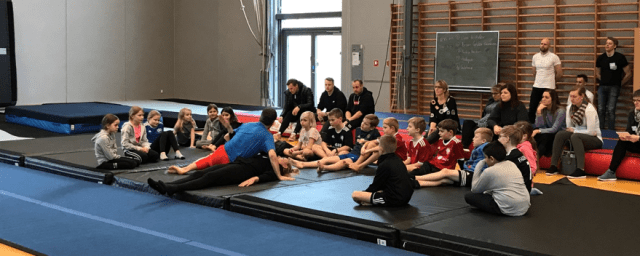JUDO I SKOLEN - FIRST FIT
It can be difficult to get potential members to visit the judo club - that is why the first meeting with them has to be where they are located the most. In the schools. The purpose of Judo in Schools is that more kids become active and find a sport which they will enjoy and that the kids will achieve better health, physical ability, well-being and learning.
The school program takes its point of departure in the FIT FIRST 10 Project. The FIT FIRST 10 concept is developed in 2019 in cooperation with SDU (University of Southern Denmark), Team Denmark, DIF (National Olympic Committee & Sports Confederation of Denmark) and 10 national sports associations. FIT FIRST is high intensity and embracing activities in the pre-preparatory classes. The activities are goal-oriented and carefully developed based on the latest knowledge on the impact that physical activity has on children's health, physical fitness level, well-being and learning. The activities are aimed at the Danish schools and the concept is evidence based.
The exercises have been developed in a way that they ensure the pupils maintain a high average pulse throughout the 40 minutes and therefore the pupils mainly work in the “aerob, high intensity”, “anaerobic, interval” and “sprint, strength” categories, as this is where you see some great positive health related impacts. Additionally all exercises take into account the skill and knowledge proficiency requirements up to the 3rd grade. The exercises enable the pupils to develop bodily, athletic, social and personal competencies. They are organised so that the pupils gain awareness to a diverse sports culture and based on the desire for movement.
PROGRAM
To make sure the program is executed the right way, the teachers are sent an electronic FIT FIRST judo manual with 6 lessons of 40 minutes duration.
The exercises must:
● Be of 40 minutes duration and applicable to be used in sports lessons and other movement lessons
● Be organised so that there are 3 lessons per week
● Be organised to ensure that periods with high pulse is achieved in all lessons
● Be for all pupils regardless of gender, culture and ability
● Be adapted to primary school children
● Be usable in the Danish school system
● Meet the professional requirements for sports in the primary school
● Be developed so that all teachers regardless of subject can teach them
● Be health oriented, involving, fun and high pulse
● Enable the pupils, through participation, to achieve a positive health beneficial effect
The cooperation is based on the local judo club’s capacity of instructors.
The Judo club makes 1-2 instructors available to the school in an agreed timeframe. The judo instructor must be viewed as a support function as the purpose is to enable the teachers and pedagogues to be able to teach the exercises from the judo manual by themselves.
An example structure of a program could look like this:
- Dialogue between the judo club and the Danish Judo Federation where it is agreed when the program should be run at the school, who contacts the school etc.
- The main instructor and the responsible teacher/pedagogue discuss and align expectations to how many times the judo instructor must be present at the school.
- The judo instructor is present at the school and educates teachers and pupils to enable the teachers to use the exercises in their sports and movement lessons. A lesson is typically of 40 minutes duration. For instance the judo instructor could teach 1-2 times at the school followed by a lesson conducted by the teacher him-/herself with support from the judo instructor.
- The teachers do the tutoring themselves and the judo instructor participates from the side line.
- The teachers receive a Judo in School diploma.
- The teachers are welcome to contact the judo instructor if any questions arise subsequently.
- The teacher and the judo instructor evaluate and provide feedback for the Danish Judo Federation for continuous improvement.
ECONOMICAL COMPENSATION
Often it can be difficult for a judo instructor to teach during the day time due to full time work. An economical compensation might help. Others view the cooperation with the school as voluntary work where a salary can be a motivator for spending daytime hours at the school. Currently the Danish Judo Federation do not have financial means to compensate the judo instructor - maybe this will change over time. But the local judo club always has the opportunity to enter into a diaogue with the school about the possibility for compensating the judo instructor financially.
Another option is to apply for compensation from the People Enlightenments Council’s development pool in the club’s/school’s municipality.
A third option is to investigate if the municipality has a pool dedicated to the Open School.
WHAT IS THE BENEFIT FOR JUDO CLUBS IN THE PROGRAM?
A motivator for the club is that the sport is exposed in local community which increases the likelihood for more members in the club. That means:
● Increased exposure of the club and spreading the knowledge of judo in the local community.
● Cooperation with the local community
● Access to potential new members
● Increased motivation and experience amongst the club’s instructors.
● Giving the children insight into judo
● Good publicity of judo in the municipalities
Do an internal alignment of expectations in the club so the board and instructors are informed about the project and agree.
Also remember to consider if the club has the necessary instructor resources available to be part of the project. It does not have to be the main instructor giving lessons at the school. It could be one of the younger instructors in the club.
EXPECTATIONS FOR PARTIES IN THE PROGRAM
The Danish Judo Federation:
● Provides judo gi’s for the pupils and puzzle mats free of charge (borrowed by IJF).
● Provides a free judo gi for the instructor including a Judo in Schools back label.
● Offers diplomas & other communication materials for the teachers
● Assists in contacting the school and coordinates between the instructor and the school as well as coordinates judo gi’s and puzzle mats if the club wants it.
● Ensures that evaluation and feedback is received by the school.
The judo clubs:
● Coordinate together with the Danish Judo Federation regarding the program etc.
● Provide the instructor who teach at the school.
● Evaluate and provide feedback for the Danish Judo Federation during or after the program has finished.
WHY JUDO
Yes, you already know but here are some more good reasons for children to practice judo.
Motorically judo has some special potentials:
● Judo will undoubtedly be able to motivate many children in the school because it is an activity that appeals to children’s fascination of combat and competition. You could also easily incorporate dramatic elements in the lessons like Kung Fu Panda, Samurais’ etc.
● Judo greatly challenges the vestibular system and sense of balance. Judo highly involves getting your opponent to lose balance while maintaining own balance. That improves the balance.
● In good age related judo-lessons there are appropriate strains and impacts to the skeleton. Judo to a great extent a weight bearing sport. You not only carry yourself but also your partner. That strengthens the bone density.
● Movement wise judo is all-round and complex in a good way as you both crawl, walk, jump, throw, lay, fall. pull. push etc. Like in gymnastics the children develop base motor control which is an important prerequisite to learn new movements and further improve oneself. Motor skills are beneficial for cognition and performance in school.
● It is not a disadvantage to weigh too much in judo. Weight is an advantage in many of the exercises and the fights. As a teacher you can choose exercises where high weight is an advantage. This is good for the overweight pupils that often drop out and can be difficult to motivate to work intensively.
● Last but not least judo to a great extent includes high intensity training elements. This is good as research shows that unfortunately it is not enough for children to jog lightly around the school, walk or bike in a moderate pace (Larsen, N. J; Knustrup, P; Wedderkopp, N., 2018). High intensity training offer exceptional positive training effects in relation to cardiovascular fitness, musculoskeletal fitness, metabolism and brain development.

 Denmark
Denmark



